Transanal Excision

The transanal excision procedure is used to treat patients with early colorectal cancer. This procedure was designed to preserve the function of the sphincter in colorectal cancer patients and eliminate any fecal incontinence.
Did you know?
The transanal excision works on stage 1 rectal cancer that’s located near the anal opening, but hasn’t spread to the anus or sphincter.
Frequently Asked Questions
How does the transanal excision work?
In earlier days of treating colorectal cancer was treated by removing the anus, sphincter, and tumors. This left patients with fecal incontinence and a slew of other issues that suddenly needed fixing.
The transanal excision works by removing only the tumors and surrounding tissue. By leaving the anus and sphincter intact patients no longer need a permanent colostomy bag.
In addition to the transanal excision, patients will likely undergo radiation or chemo to ensure they’re cancer free.
What is the transanal excision procedure like?
This procedure is performed under general anesthetic. Once you’re situated on the operating table the doctor will enter the anus without cutting any skin. He or she will remove polyps using a variety of techniques.
One such technique is through the use of a wire snare, which is looked around polyps and then electrified to burn and cauterize the polyps. Oddly shaped polyps will be removed with other tools. A small bit of surrounding tissue is also removed, in case it is cancerous.
What is recovery like?
Recovery from the procedure requires that you stay in the hospital for at least one night. The doctor will review what they did during the procedure and what your prognosis is. It’s advisable to have someone with you who can process the conversation, as after surgery your memory may be fuzzy. Bloating and gas are common side effects after the procedure, but subside over time.


